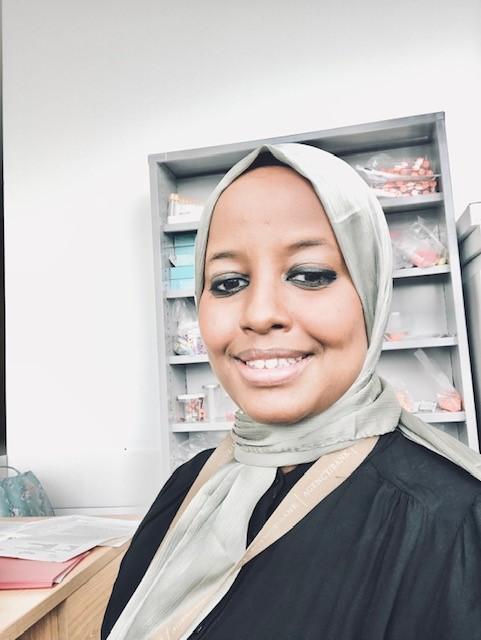Celebrating a New Milestone at the PCRF Tissue Bank
Q&A with Amina Saad, Tissue Collection Officer
The Pancreatic Cancer Research Fund (PCRF) Tissue Bank, the world’s first national pancreas tissue bank, is a vital resource aimed at accelerating ground-breaking research on early diagnosis and treatment for pancreatic cancer. Based at Barts Cancer Institute (BCI), Queen Mary University of London, the Tissue Bank collects samples from patients from across the nation who have been diagnosed with pancreatic cancer or other conditions of the pancreas.

Recently, the PCRF Tissue Bank registered its 1,000th tissue donor, reaching a new milestone. We spoke with Amina Saad, who is responsible for over 660 donor registrations, including the Tissue Bank’s 1,000th registration, about her role as a Tissue Collection Officer within the Tissue Bank team.
What does a typical day involve for you working as a Tissue Collection Officer at the PCRF Tissue Bank?
My day as a Tissue Collection Officer begins with attending the clinic at the Royal London Hospital. Here, I approach patients with different pancreatic conditions, or disease associated with the pancreas, and ask if they would like to donate samples to the PCRF Tissue Bank. Upon their consent, I collect a sample of their blood, urine, and saliva and process them in the biochemistry laboratory in the hospital. I also interact with the surgical team if a patient is having surgery, informing them that their patient has given consent to donate a sample of their tissue and to notify me once the tissue specimen is ready for collection. Once ready, I take the tissue specimen and work with the pathology team who assess and prepare a sample from the tissue to be stored in the PCRF Tissue Bank.
What sort of tissues are collected from patients? Do you find patients to be willing to partake in the Tissue Bank?
In the clinical setting, I collect urine, blood, and saliva whereas in the surgical setting, I collect both blood and tissue. We collect tissues of different types including tissue from pancreatic ductal adenocarcinomas and premalignant tissues, such as intraductal papillary mucinous neoplasm (IPMN) or inflammatory tissue from patients with pancreatitis. While we also collect tissues from healthy donors, which represent a positive control in our laboratory research, tissue from pancreatitis patients can also act as a control given its similarity to healthy tissue. The majority of patients I encounter applaud our work and are very willing to partake in the Tissue Bank. They are often happy to hear that there is a tissue bank available and that their samples can be used to help find a cure for pancreatic cancer.
What happens to the patient samples after they have been processed? Why are these samples so important for pancreatic cancer research?
At the Royal London Hospital, patient tissue is frozen through a snap freezing technique. Blood samples, on the other hand, are centrifuged and aliquoted according to our hospital guidelines. These samples are then transported to the BCI where they are stored and catalogued with anonymised data about the sample and patient. From here, the samples can be distributed to researchers. Patient tissue samples are important for research because they represent the true nature of human disease and can help improve our understanding of the disease progression pathway and other mechanisms involved. By understanding these mechanisms, researchers can develop better therapies and diagnostic approaches that can be less invasive and more effective in the future.
Why did you decide to work as a Tissue Collection Officer for the Tissue Bank? What do you enjoy most about your role?
Being part of an organisation that continues to address the issue concerning pancreatic cancer is very rewarding. Even more so, my role as a Tissue Collection Officer is incredibly diverse; it is not only based in the laboratory but also gives me the opportunity to attend clinics, surgeries, and multidisciplinary team meetings. I therefore learn continuously, which I love. If you had asked me to identify a pancreas in a CT scan before I had started this role, I wouldn’t have been able to answer. But now I can confidently identify all the organs as a result of the experience and opportunities in my role. I also appreciate my team at the BCI and the Royal London Hospital, and value the wonderful patients I interact with, particularly the elderly who often like to share stories from their lives when I see them in the clinic.
What's your biggest hope for the PCRF tissue bank in the next decade?
Pancreatic cancer has the lowest survival rate of all the common cancers, a trend which has continued for almost four decades. Over the next few years, I hope the PCRF Tissue Bank can break this cycle by accelerating research and enabling researchers to conduct laboratory work on novel treatments and early diagnostic approaches for pancreatic cancer that can be translated to a clinical setting.
More information:
- If you would like to find out more about donating to the PCRF Tissue Bank or be involved in raising money for more research into beating pancreatic cancer, you can visit pcrf.co.uk
- Information for researchers: https://www.thepancreastissuebank.org/ResearcherInfo.html
This article was put together by Radhisha Kohombage, MSc student (MSc Cancer & Molecular and Cellular Biology, 2021-2022)
Category: General News, Interviews

No comments yet